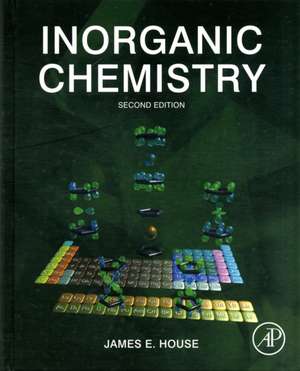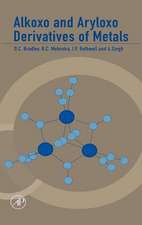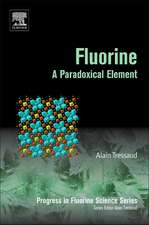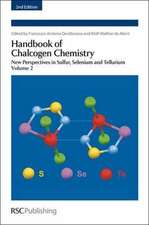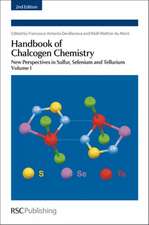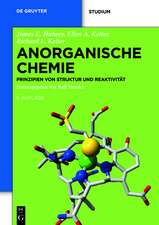Inorganic Chemistry
Autor James E. Houseen Limba Engleză Hardback – 28 oct 2012
The textbook contains a balance of topics in theoretical and descriptive chemistry. For example, the hard-soft interaction principle is used to explain hydrogen bond strengths, strengths of acids and bases, stability of coordination compounds, etc. Discussion of elements begins with survey chapters focused on the main groups, while later chapters cover the elements in greater detail. Each chapter opens with narrative introductions and includes figures, tables, and end-of-chapter problem sets.
This new edition features new and improved illustrations, including symmetry and 3D molecular orbital representations; expanded coverage of spectroscopy, instrumental techniques, organometallic and bio-inorganic chemistry; and more in-text worked-out examples to encourage active learning and to prepare students for their exams.
This text is ideal for advanced undergraduate and graduate-level students enrolled in the Inorganic Chemistry course. This core course serves Chemistry and other science majors. The book may also be suitable for biochemistry, medicinal chemistry, and other professionals who wish to learn more about this subject area.
- Concise coverage maximizes student understanding and minimizes the inclusion of details students are unlikely to use
- Discussion of elements begins with survey chapters focused on the main groups, while later chapters cover the elements in greater detail
- Each chapter opens with narrative introductions and includes figures, tables, and end-of-chapter problem sets
| Toate formatele și edițiile | Preț | Express |
|---|---|---|
| Paperback (1) | 709.83 lei 36-50 zile | |
| ELSEVIER SCIENCE – 29 oct 2019 | 709.83 lei 36-50 zile | |
| Hardback (1) | 465.52 lei 36-50 zile | |
| ELSEVIER SCIENCE – 28 oct 2012 | 465.52 lei 36-50 zile |
Preț: 465.52 lei
Preț vechi: 605.65 lei
-23% Nou
Puncte Express: 698
Preț estimativ în valută:
89.07€ • 93.25$ • 73.71£
89.07€ • 93.25$ • 73.71£
Carte tipărită la comandă
Livrare economică 31 martie-14 aprilie
Preluare comenzi: 021 569.72.76
Specificații
ISBN-13: 9780123851109
ISBN-10: 0123851106
Pagini: 848
Ilustrații: illustrations
Dimensiuni: 191 x 235 x 38 mm
Greutate: 1.75 kg
Ediția:Revised
Editura: ELSEVIER SCIENCE
ISBN-10: 0123851106
Pagini: 848
Ilustrații: illustrations
Dimensiuni: 191 x 235 x 38 mm
Greutate: 1.75 kg
Ediția:Revised
Editura: ELSEVIER SCIENCE
Public țintă
This text is ideal for advanced undergraduate and graduate-level students enrolled in the Inorganic Chemistry course. This core course serves Chemistry and other science majors.The text may also be suitable for biochemistry, medicinal chemistry, and other professionals who wish to learn more about this subject area.
Cuprins
I. STRUCTURE OF ATOMS AND MOLECULES 1 Light, Electrons, and Nuclei 2 Basic Quantum Mechanics and Atomic Structure 3 Covalent Bonding in Diatomic Molecules 4 A Survey of Structure and Bonding 5. Symmetry and Molecular Orbitals II. CONDENSED PHASES 6. Intermolecular Interactions 7 Ionic Bonding and Structures of Solids 8. Dynamic Processes in Solids III. SOLUTION CHEMISTRY OF INORGANIC COMPOUNDS 9. Acid-Base Chemistry 10. Chemistry in Nonaqueous Solvents 11. Redox Chemistry IV. SURVEY OF THE CHEMISTRY OF MAIN GROUP ELEMENTS 12. Chemistry of Metallic Elements (production, reactions, typical behavior) 13. Organometallic Compounds of Main Group Metals 14. Chemistry of Nonmetallic Elements (emphasis on H, O, N, S, P, and halogens) V. CHEMISTRY OF COORDINATION COMPOUNDS 15. Introduction to Coordination Chemistry 16. Ligand Field Theory 17. Interpretation of Spectra 18. Molecular Orbitals in Complexes 19. Composition and Stability of Complexes 20. Synthesis and Reactions of Coordination Compounds 21. Organometallic Coordination Compounds 22. Coordination Compounds in Catalysis and Biochemistry23. Bioinorganic Chemistry
Recenzii
"Each chapter is well referenced and includes plenty of homework problems…for those advanced students who have completed physics and calculus, this would be an excellent resource for obtaining a thorough coverage of inorganic chemistry…Summing Up: Highly recommended." --CHOICE, August 2013
"In a textbook for a one-semester upper-level introductory course in inorganic chemistry, House…selects topics to provide essential information in the major areas of the field such as atomic and molecular structure, condensed phases, acid-base chemistry and solvents, coordination chemistry, ligand field theory, and solid-state chemistry." --Reference and Research Book News, February 2013
"In a textbook for a one-semester upper-level introductory course in inorganic chemistry, House…selects topics to provide essential information in the major areas of the field such as atomic and molecular structure, condensed phases, acid-base chemistry and solvents, coordination chemistry, ligand field theory, and solid-state chemistry." --Reference and Research Book News, February 2013
